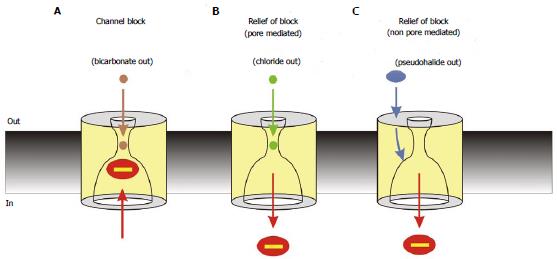Copyright
©2014 Baishideng Publishing Group Co.
World J Biol Chem. Feb 26, 2014; 5(1): 26-39
Published online Feb 26, 2014. doi: 10.4331/wjbc.v5.i1.26
Published online Feb 26, 2014. doi: 10.4331/wjbc.v5.i1.26
Figure 7 Interactions between cytoplasmic blocking anions and extracellular anions.
Cytoplasmic block is modified by extracellular anions by different mechanisms, leading to different degrees of block under different conditions. A: Block is strong in the absence of modulation of block by extracellular anions; physiologically, such a condition may occur during periods of epithelial HCO3- secretion, leading to strong block of cystic fibrosis transmembrane conductance regulator (CFTR) channel currents under these conditions[101]; B: Block is weakened by extracellular anions that can enter the channel pore, such as Cl-, due to an electrostatic “knock-off” mechanism. This may lead to increased CFTR channel currents during periods of epithelial Cl- secretion[101]; C: Block is weakened by extracellular anions that interact with an extracellular part of the protein involving extracellular loop 4. This is presumed to result in a long-range conformational change in CFTR that decreases the affinity of the cytoplasmic blocker binding site. This mechanism may allow pharmacological manipulation of CFTR activity by compounds that interact with the extracellular anion binding site[114]. Note that Cl- ions may also interact with intracellular blocking anions by the non-pore mediated effect shown in (C)[114].
- Citation: Linsdell P. Cystic fibrosis transmembrane conductance regulator chloride channel blockers: Pharmacological, biophysical and physiological relevance. World J Biol Chem 2014; 5(1): 26-39
- URL: https://www.wjgnet.com/1949-8454/full/v5/i1/26.htm
- DOI: https://dx.doi.org/10.4331/wjbc.v5.i1.26









